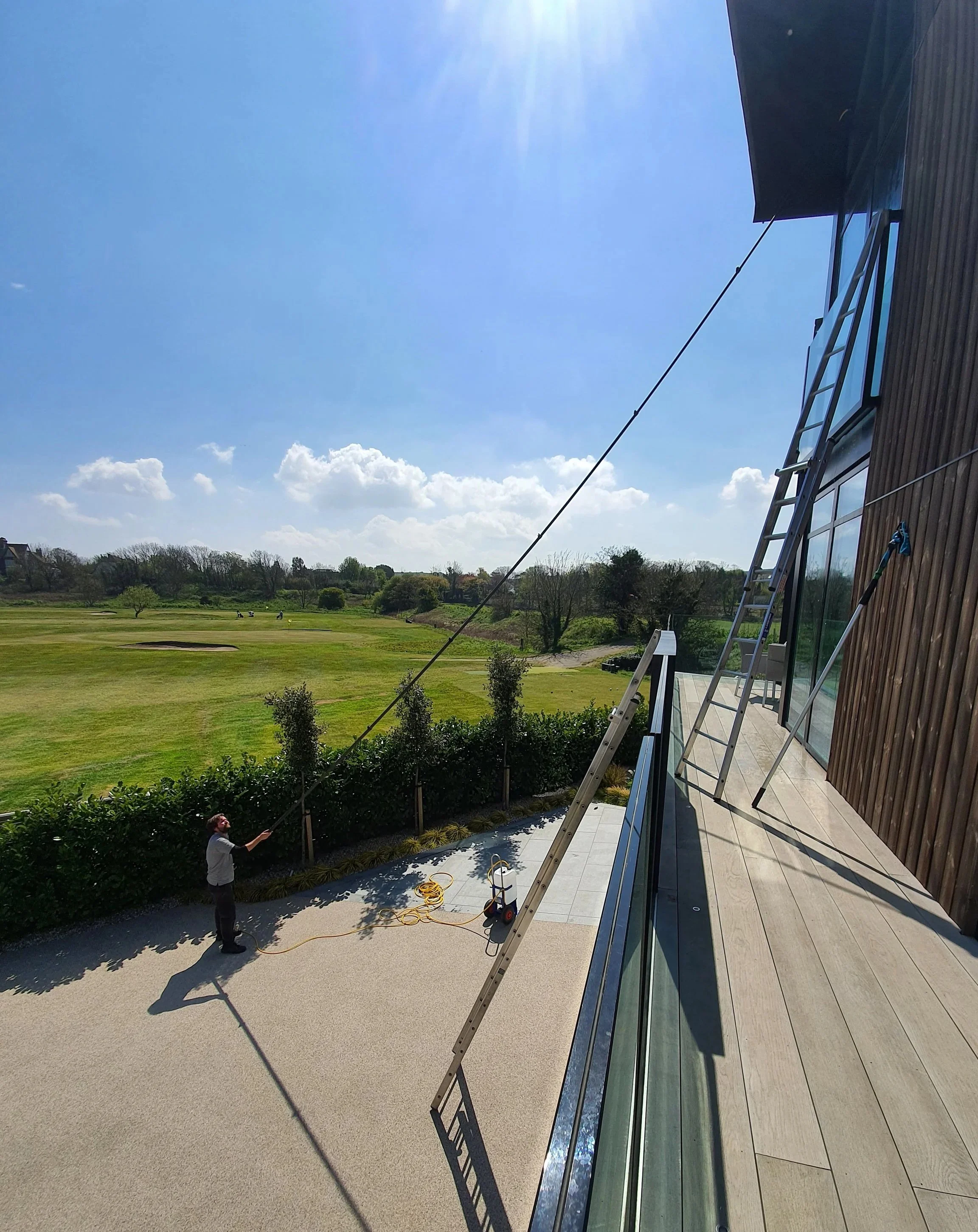Exciting changes are afoot
as we move towards cleaning more windows with the water-fed pole method
Over the coming months, we will be increasing our capacity to provide window cleaning via the water-fed pole method (WFP; also known as the Reach and Wash Method), kitting out our vans with the necessary, state of the art equipment.
While we will continue to offer traditional cleans where appropriate we will also begin to transition towards using the WFP approach for a larger proportion of cleans.
What is the water-fed pole method?
Water fed pole systems use ultra pure water, fed through an extendable, telescopic pole with a brush to clean windows from the ground.
Benefits of the Water-Fed Pole Method
significantly improved safety for our staff while also reducing work-related wear and tear on their bodies (traditional window cleaning is risky and hard physical work!)
improved clean efficiency
more effective cleaning of frames
the ability to clean hard to reach windows e.g. dormer windows or those above conservatories
Water-Fed Pole FAQs
What does this mean for me?
The roll out of the water-fed pole (WFP) method across the round will happen gradually over the next few months.
We will assess each job individually and decide on the most appropriate and effective method for window cleaning at the property.
Wherever possible, we will transfer our existing window cleaning customers over to a WFP clean. Occasionally, a mix of methods may be best.
What’s the difference between a traditional window clean and a WFP clean?
Traditional window cleaning involves using hand tools such as squeegees and scrims, along with tap water and a detergent, to clean windows. It requires the use of ladders to reach higher level windows. WFP cleans use ultra pure water which is free of impurities, fed through an extendable, telescopic pole with a brush, to clean windows from the ground.
Will the quality of my clean change?
When done properly, with the correct equipment, WFP cleans are just as good as traditional cleans, if not better. If anything, you’ll see an improvement in the finish, especially around the frames.
Traditional methods can leave some residual dirt and soap residue around the frames which will need to be flushed out with the WFP. For this reason it is possible that, initially, as we transition from one method to another, it may take more than one WFP clean to get the windows and frames completely clean. As always, all WFP cleans are covered by our guarantee so if there’s anything you’re concerned about with regards to your clean, please do get in touch.
As with traditional cleans, if window are very dirty, it may take a couple of cleans with a WFP to bring them up to standard.
I'd still rather have my windows cleaned traditionally. Is this possible?
For some properties it will make sense for us to continue to clean the windows traditionally. For others, we'd love to have the opportunity to demonstrate how good a WFP clean can be when carried out by our skilled team. In everything we do, we strive for excellence and our ultimate aim is to provide you with wonderfully clean windows!
Will my windows be left wet?
Yes, they will. But, because we are using ultra-pure water that is free from impurities such as minerals or detergent residues, they will dry spotless and streak free. Wiping the windows after the clean is not advised as it disturbs the pure water finish and could leave streaks.
Can you still clean the sills using a WFP?
Yes, absolutely. We will continue to clean glass, frames and sills as standard on every WFP clean.
How do you clean the upper window sills properly if you can’t see them?
The sills on upper floors are inevitably cleaned blind but we are taking care to include them in all cleans. We know from experience of cleaning ground floor sills what is generally required to achieve a clean sill and will apply the same approach on upper window sills.
How do you ensure the glass is clean if you’re not up close to it?
There are various ways that we assess whether the glass is clean when using the WFP approach. For example:
we can see when the water is running clear - this is a good indication of the glass being clean
it’s possible to feel when the glass is extra dirty as it feels rougher through the pole
looking up across the surface of the glass from below is a good angle to check it from (we know this from traditional window cleaning) as you have the reflection of the sky which helps highlight dirt on the windows
the flow of the water on the glass is impacted by even small specs of dirt stuck to the glass
Will the WFP approach be used for internal window cleaning?
No, WFP systems are designed for external window cleaning only. We will continue to do all internal cleans using traditional methods.
Why does using WFPs improve staff safety?
Safety is a major benefit of using WFP systems. A WFP system allows staff to work from ground or very low level reducing the risks of working at height and from a ladder.
If my window frames are in poor condition, will this impact the quality of the finish?
Yes, in theory it could, but this would also be the case if using traditional methods. Whichever approach we use, we would assess frame condition at quote stage and decide on the most appropriate method for the clean. We would then proceed extremely gently, minimising the likelihood of disturbing frame material and moving it on to the glass. This could happen, for example, with old powder-coated aluminium frames or painted wooden frames which have become flaky.
What if my front door leaks?
Some front doors may let a small amount of water through damaged seals or even through the letterbox depending on the design. If this is the case with your front door please let us know and we will add a note to the job to take extra precautions to avoid this.
Will the hoses get in my way or the way of others?
We will follow best practice when it comes to placement of the hoses used for WFP cleans. Our hoses are bright yellow so are highly visible and we will make every effort to ensure the hoses are placed so as not to be trip hazards. Where necessary (e.g. if the hose has to cross a public pavement), we will use appropriate signage to alert people to the presence of the hose.
Is the WFP system safe to use close to overhead cables or in strong wind?
There are risks associated with using WFPs in close proximity to overhead power cables or in strong winds. When quoting jobs or on our first visit we would consider the presence of overhead cables when deciding on the appropriate clean method for that property and, where necessary, follow all health and safety guidance on using WFPs near overhead cables.
In terms of strong winds, we carefully monitor the weather forecast and would postpone cleans on days where the wind is too strong for the safe use of the poles. The same is true for traditional methods, as ladders are also unsafe to use in strong winds.
In freezing conditions, could water from the poles freeze on pathways or driveways causing a slip hazard?
In such conditions we will take additional precautions to reduce the chance of this happening. For example, reducing the amount of water used around front doors and spreading salt on any potential problem areas before we leave your property.
Will the price of my clean increase?
There will be no increase in price if you are transitioned to a WFP clean.
Will the frequency of my clean need to change?
The frequency of your clean will stay the same.
The RJT Promise: Happiness Guaranteed
As always, we remain committed to providing outstanding cleans and excellent customer service. All WFP cleans will remain covered by our guarantee so if you’re ever not satisfied with a job we have done, simply let us know within 24 hours and we will come back and make good, no questions asked.




